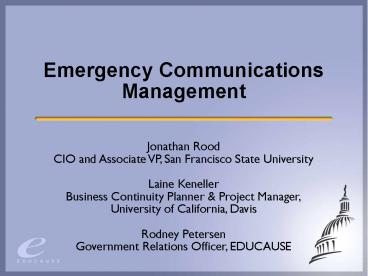Emergency Communications Management - PowerPoint PPT Presentation
Title:
Emergency Communications Management
Description:
Emergency Communications Management Jonathan Rood CIO and Associate VP, San Francisco State University Laine Keneller Business Continuity Planner & Project Manager, – PowerPoint PPT presentation
Number of Views:307
Avg rating:3.0/5.0
Title: Emergency Communications Management
1
Emergency Communications Management
- Jonathan Rood
- CIO and Associate VP, San Francisco State
University - Laine Keneller
- Business Continuity Planner Project Manager,
- University of California, Davis
- Rodney Petersen
- Government Relations Officer, EDUCAUSE
2
EDUCAUSE Western Regional Conference 2008
Planning for the UN-planned
- Real time Connections
- With Technology
- Emergency Communications Management
3
- Emergency Communications System
- Great Expectations
- Can notify 40K individuals in seconds
- Will be able to explain exactly what action to
take - Will know when to send updates and what
information to include - Everyone will know what to do especially
faculty, as students will turn to them in a
crisis - Appropriate individuals will be available at the
exact start of the emergency and be available to
collaborate
4
- Emergency Communications System
- in Practice (Reality Check)
- Takes time to make messages that are clear,
instructive - Need many backups of responsible assigned staff
- Overlapping messages may cause confusion
- Txt and voice message must be brief but
recipients have many questions - System is needed beyond initial incident Plan
beyond the message, with pre-established roles
for faculty, staff, managers - Message should follow pre-set guidelines which
include - message delivery times
- anticipated number of follow-up notices
- user comprehension
- type of emergency
- understanding of pre-established leadership roles
- all established procedures
5
- System Requirements
- More Than a Little Software
- Extensive feature set, including
- Schedule/send to multiple phones peer user plus
text, e-mail, TTY - Group management
- Reporting tools with statistical results
- Contact administration for delete, add, change
- Assurance that calls have priority routing
- Hassle-free data upload with flexible attributes
6
Integration with Civic Infrastructure
- Adoption of city / state emergency communication
systems - Tap into civic services / notifications
- Two-way communication call / response for
skilled resources - e.g., need available electricians/nurses/language
translators - Identification, notification, and authentication
by skill/certification - Campus can both request and provide resources
7
- Ready, Set,
- Delivering a System
- Need policies, procedures, task assignments
- Whos involved? University Police, Information
Technology, Human Resources, Public Relations /
Communications, Enrollment Services and
Registrations, Student Affairs, Health Center,
Faculty Affairs, Administration Finance and
more - Security of personal data and policies for use of
contact data - Collecting datahow to encourage, mandate vs.
opt-in - Testing, small, medium and full scale
- Creating a feedback loop
- Ongoing review process
8
UC Davis Emergency Notification System
- UC Davis began RFP process in June of 2006
- Committee representation from Police Department,
Operations and Maintenance, Purchasing and IET - September 2007, the last phase in the purchase
process was completed
9
We Have Your Number!
- Chancellors Taskforce created in October 2007
- API built from on-line directory to WARN
- 54,000 records uploaded
- December 2007, Chancellor sent email asking
faculty staff to update contact info
10
Network Test
- 5 separate tests
- Clearly defined goals
- 2 day time frame
- 13,000 participants
- Staff, Faculty Students
11
Interesting Test Facts
First message acknowledged 1 second from test
initiation
- Speed of Delivery per Device
- SMS Text Messaging / Cell
- Work Phones
- Pagers
Number of emails delivered on campus within 5
seconds 76
- March Incident Approx 55,000 emails sent and
received within 16 minutes
12
Technical Issues Identified
- Incoming carrier trunk capacity issues
- Missing calls not received during test
- Majority of pager messages not delivered
- Approximately 800 emails unaccounted for
13
Whats Next?
- Modify on-line directory to accept emergency
information - Public Awareness Campaign
- Determine ongoing testing schedule
- In the absence of industry standards, need to
establish UC System benchmark - What of population should be notified?
- How soon should they be notified?
- Continuous improvement
14
Implementation Tool Kithttp//vpiet.ucdavis.edu/e
ms/
- Functional Requirements
- RFP
- Vendor Scoring Matrix
- Chancellors Charter Letter
- Emergency Notification Policy
- Test Plan
- Test Results
- Communication Plan
- FAQs
15
Discussion
- Share your experiences and questions with your
colleagues as together we sketch out a roadmap to
providing this important service. - Who must be involved in the planning and
management of these systems? - What policies are needed?
- What is happening on your campus?
- Other questions?
16
Resources
- EDUCAUSE Emergency Communications Constituent
Grouphttp//www.educause.edu/15272 - EDUCAUSE Connect Emergency Notification
Systemshttp//connect.educause.edu/term_view/Emer
gencyNotificationSystems - NACUBO Campus Safety and Security
Projecthttp//www.nacubo.org/x10053.xml































